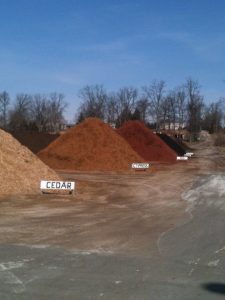Why do I need to use mulch under my tree?

Mulching under a tree has several benefits to a tree—
• It helps to control weed germination and growth
• It helps to reduce soil moisture
• It helps to protect the tree from potential damage from lawn mowers and weed eaters
• It insulates the soil and helps to keep the tree’s roots cooler in the summer and warmer in the winter
• It can help to improve existing soil as it decomposes
• It can inhibit plant diseases
In a natural forest setting, a tree is constantly being mulched and “fed” by decomposing leaves, organic materials, and living organisms. The leaves are ever present as the tree drops them in the fall, where they gather under the tree’s branches. These are a constant source of organic material. Insects, fungi, and small animals make use of these leaves, adding to the organic material that builds up over time. This natural “mulch” is full of nutrients that provide the root system of the tree a constant source of the macronutrients nitrogen, potash, phosphorus acid, and the micronutrients, magnesium, manganese, sulfur, iron, etc.
In this natural setting, the tree has no competition from grass or weeds, or a lack of growing area, poor soils, or reduced organic matter.
What kinds of mulch are there and what is the best type to use?
Two types of mulch are those that are organic and those that are inorganic. Some of the organic mulches include: wood chips, pine needles, hardwood mulch, leaves, and compost. All these organic mulches will eventually decompose and be beneficial to the soil where the tree’s root system exists. All the above mulches decompose at different rates, and therefore replenishing the mulch will be dependent upon what type is used.
Some of the inorganic mulches include: different sizes and types of rock, lava rock, geotextile fabrics, and recycled rubber. Inorganic mulches do not decompose and do not need to be replenished. These types of mulches do not improve the soil, do not keep out weeds, and do not keep the soils under the trees at more constant temperatures.
How much mulch should I use?
In the urban setting, adding mulch under the tree at a 2”-3” depth helps the tree mimic its natural and optimum growing condition.
Normally, it is not feasible to mulch the area where the tree’s roots encompass. To measure the size and scope of a tree’s root system, one takes the height of the tree and multiplies by three. That will give you the diameter of the tree’s root system. Divide by two, and that will give you how far out the roots radiate from the base of the tree. So, as an example, if you have a Maple tree in your front yard that is 60’ tall, the diameter of the root system of this tree would encompass 180’, and its roots would radiate outward from the trunk 90’ in all directions.
If it were up to the tree, the entire area where the roots extend would be mulched. But in a residential area, this is normally not possible. If you can, mulch out to the edge of a tree’s canopy. Again, sometimes this is not possible, so 2’-3’ from the base of the tree is usually enough.
Never use more than 2”-3” depth of mulch! Too much is definitely NOT a good thing!
There are several detrimental effects to using too much mulch around a tree:
• Deep mulch can cause the roots to die from lack of oxygen and lack or too much moisture.
• Piling mulch against the tree’s base (trunk) can cause that area to remain moist and lead to an entryway into the tree’s system for damaging insects and disease.
• Piling mulch up can lead to a rodent habitat.
• Deep mulch will not decompose naturally but will form a thick mat, which will inhibit water and air.
• Deep mulch can become anaerobic (lacking oxygen) and makes for a great growing habitat for molds and fungi, which can be toxic to the tree and its root system.
For areas under the tree that have already been mulched, before adding any new mulch, check to see the depth and health of the existing mulch. If the old mulch is matted, it can usually be broken up with a rake. Sometimes, the old mulch can be flipped over to give it a new and fresh appearance. This is preferable to adding new mulch onto the old, matted mulch.
Visit Natural Products LLC for great deals on all natural mulch



